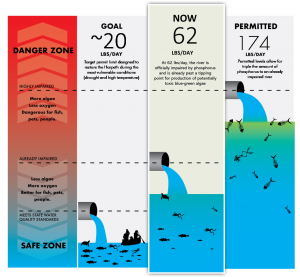Algal Blooms
Algae
The term algae refers to a diverse group of aquatic plant life, which ranges from single-celled organisms to seaweeds and kelps. Algae are an essential part of fresh and saltwater environments by providing a food source for a wide variety of fish and macroinvertebrates. Additionally, half of the oxygen produced on Earth is from microscopic single-celled algae known as phytoplankton. Phytoplankton require nutrients (primarily phosphorus and nitrogen) and sunlight to produce oxygen in a process known as photosynthesis. Unfortunately, increasing levels of nutrients in water can promote the growth of cyanobacteria, photosynthetic bacteria which is also known as “blue-green algae”. Cyanobacteria can grow and spread at alarming rates in aquatic environments and these instances of unrestricted growth are known as Harmful Algal Blooms (HABs).
Toxic Algal Blooms
Toxic algal blooms, also known as hazardous algal blooms or HABs for short, form when excess nutrients are available in combination with warm temperatures and high amounts of solar radiation (sunlight). While nutrients, specifically phosphorus and nitrogen, are essential building blocks for aquatic life, excessive amounts can be extremely harmful and result in nutrient pollution. Nutrient pollution in combination with hot summer conditions and slow-moving water are the ideal circumstances for harmful algal blooms.
Toxic algal blooms can outcompete native plants for resources, increase bacterial growth and produce dangerous toxins that can affect and even kill people and animals. On top of that, when the algae die and decompose, oxygen levels in the water are depleted resulting in hypoxic (low-oxygen) or anoxic (zero-oxygen) conditions. These conditions are deadly to fish and other aquatic species that need oxygen to survive. The Gulf of Mexico’s “Dead Zone” is an extremely large area of hypoxic/anoxic conditions that occurs at the mouth of the Mississippi River – as a result almost no marine life is able to live in the Dead Zone.
Toxic algal blooms have deleterious effects on environmental health that directly lead to economic impacts such as decreases in ecotourism, elevated water treatment costs, reduction in commercial fishing, and lower property values. For example, the National Oceanic and Atmospheric Administration (NOAA) estimated that the toxic algal bloom on Lake Erie in 2014 resulted in $65 million impact to the economy and nationwide toxic algal blooms cost the U.S. seafood and tourism industries $82 million a year.
Nutrient Pollution
Both algae and nutrients are essential to aquatic environments. Nutrients support the growth of algae, which is an important food source for fish and other marine animals. However, excessive amounts of nutrients, specifically nitrogen and phosphorus, lead to nutrient pollution and conditions that are ideal for HAB growth. Nutrient pollution can be sourced from several inputs, such as agriculture, industrialization, urban development, atmosphere and even groundwater. While both natural and anthropocentric actions have contributed to this issue, it is known that nutrient pollution from human activities have increased harmful algal blooms.
Where does Nutrient Pollution Occur?
Everywhere! Nutrient pollution and harmful algal blooms affect air and water across the entire country. According to the EPA more than 100,000 miles of rivers and streams, around 2.5 million acres of lakes, reservoirs and ponds, and over 800 square miles of bays and estuaries just in the United States are affected by nutrient pollution and vulnerable to harmful algal blooms.
A new survey done by the NRDC mapped HAB events across the U.S. between 2008 and 2018. Currently, 16 states, including Tennessee, do not collect data on HABs – hence the reason TN is grayed out on the map below. Without active monitoring programs it is impossible to know when and where HABs occur or if they are producing dangerous toxins.
How to Recognize a Harmful Algal Bloom
Look for the colors green, red, blue or brown. Harmful algal blooms can look like spilled paint and/or spotted greenish dots on the surface of the water. They can also have a bad odor. Below are two pictures of harmful, toxin producing algal blooms.
Below are two pictures of non-toxic green algae for comparison. Healthy algal blooms will have a floating raft or stringy/hair-like appearance like pictured below.
Things YOU can do to Help
- Report any signs of Toxic Algal Blooms. Download the Water Reporter App and posting anytime you see potential toxic algal blooms or any other problematic situations.
- Test your soil before fertilizing it. You can use our soil testing kits to make sure you are not adding in excessive amounts of nutrients. This will help you avoid nutrient polluting and save you money!
- Stay away from phosphorus heavy detergents, soaps, cleaners, etc. and be sure to use the appropriate amounts. Always try to avoid using too much of any detergents, soaps, or cleaners.
- Always pick up after your pet!
- Use less water and energy. Turn off the lights and appliances around the house, take shorter showers, etc.
- Go to https://www.epa.gov/nutrientpollution/what-you-can-do-your-home for more information on what you can do from home to help.
Latest Posts

Discharge Permit for Franklin Sewer Treatment Plant
Email Petition Instructions: Use our email petition form to the left in order to send a message to Tennessee Department of Environment and Conservation (TDEC)

Action Alert: Franklin Sewer Permit
YOUR ATTENDANCE AT THE AUGUST 30, 2022 PUBLIC HEARING AND WRITTEN COMMENTS TO TDEC ARE CRITICAL! THE HARPETH RIVER IS STILL IMPAIRED, BUT THE DRAFT
















